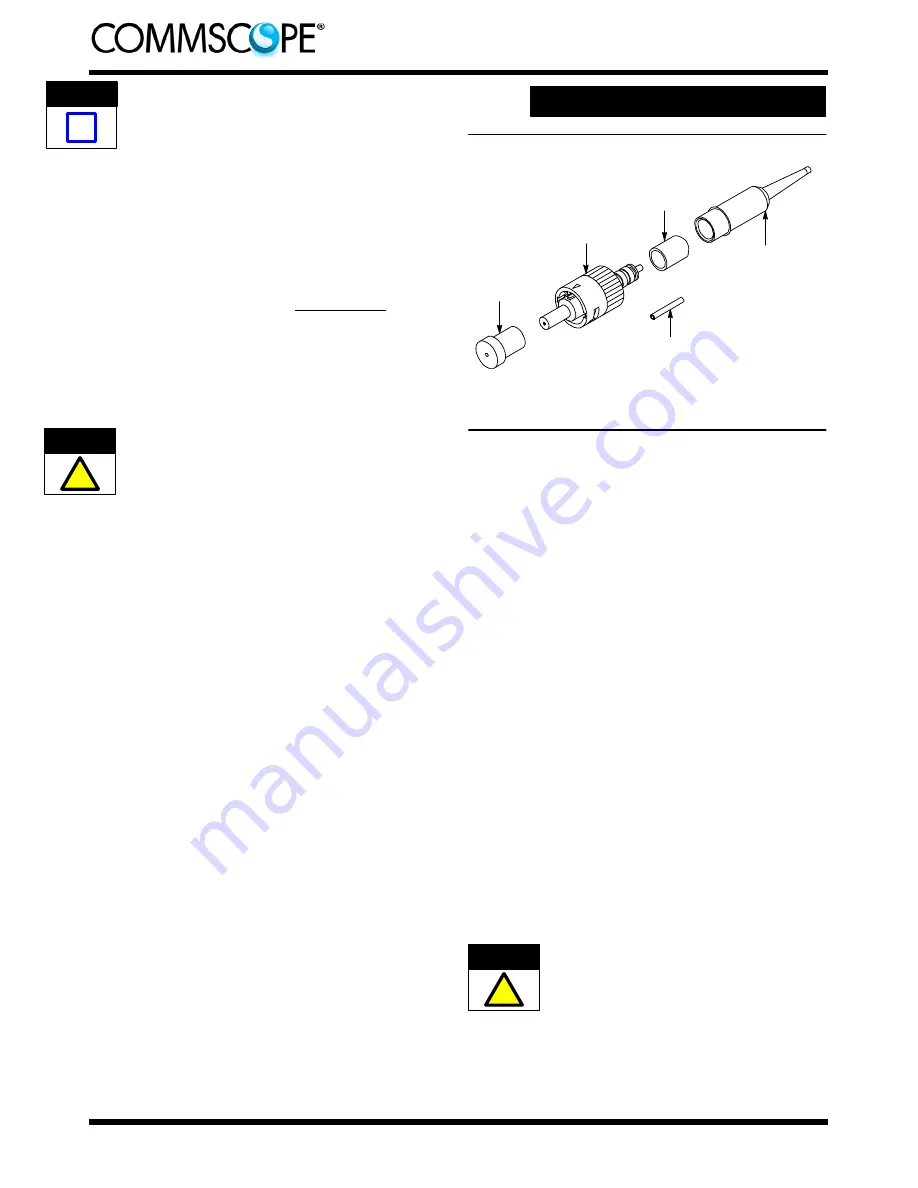
408- 4457
3
of 16
Rev
J
Make sure that the fiber does not pull rearward
from the contact (with the internal fiber) during
the crimping operation.
3. Squeeze the handles of the hand tool until the
ratchet releases. Allow the handles to open fully.
Slowly close the handles until you hear three clicks
from the ratchet.
4. With the connector assembly in the cable
holder, position the ferrule protective cover in the
upper cavity of the front die and the plunger in the
upper cavity of the rear die. It is importantto make
sure that the tip of the plunger sits in the channel
of the rear die with the protruding disk of the
plunger flat against the wall of the cavity. If the
plunger is not positioned correctly, it will be
crushed when the tool is actuated. See Figure 5,
Detail A.
The arrows marked on the front die indicate the
direction that the ferrule protective cover must be
pointing when the connector is positioned in that
cavity. For proper placement, and to avoid
damage to the fiber, the direction of the arrows
must be observed. Refer to Figure 5, Details A
and B.
5. Gently push the buffer toward the connector to
make sure that the fiber is still bottomed, then
slowly squeeze the tool handles together until the
ratchet releases. Allow the handles to open fully,
and remove connector assembly from the dies.
6. Position the plunger of the connector assembly
in the first (smallest) cavity of the front die with the
shoulder of the plunger against the edge of the
groove in the die and the ferrule protective cover
pointing in the direction of the arrow. See Figure 5,
Detail B.
7. Slowly squeeze the tool handles together until
the ratchet releases. Allow the handles to open
fully, and remove the connector assembly from the
die.
8. Open the cable clamp of the cable holder, and
remove the buffer from the clamp. Slide the bare
buffer boot over the plunger until the boot butts
against the connector. See Figure 5, Detail C.
9. Remove the connector assembly from the cable
holder.
The assembly procedure for 900--
m
m bare buffered
fiber is now complete.
"
If connecting connectors, inspect the ferrule end
face for cleanliness using 200
¢
Microscope Kit
1754767--1 (includes 2.5--mm adapter cap).
5.2.
250-
m
m Coated Fiber
Kit Components Required
(Discard Other Components)
Small
Tubing
Connector
Assembly
Bare Buffer
Boot
Plunger
Protective
Cap
Connector kit is shipped with these installed onto connector
assembly. Keep them in place until ready for assembly.
Ferrule
Protective
Cover
A. Preparing 250-
m
m Coated Fiber
(Figure 2)
1. Slide the bare buffer boot (small diameter end
first) over the fiber. See Figure 2, Detail A.
2. Remove the ferrule protective cover and the
plunger protective cap from the connector
assembly. Keep the cover; discard the cap.
3. Insert the small (white) tubing into the plunger of
the connector assembly until the tubing bottoms.
See Figure 2, Detail A.
4. Push the connector into the holder of the cable
holder with the ferrule protective cover facing
outward. See Figure 2, Detail B. Make sure that
the connector butts against the lip of the arm of the
cable holder. Slide the fiber into channel marked
“BUFFER” on the cable holder. Make sure that the
tip of the fiber butts against the end of the channel.
5. Mark the fiber at each cross--slot of the channel.
See Figure 2, Detail B. Remove the fiber from the
cable holder.
6. Using the strip tool, strip the fiber to the first
mark. It is recommended holding the strip tool at
an angle to the fiber and stripping the fiber in three
sections. See Figure 2, Detail C. Clean the fiber
with an alcohol fiber wipe to remove the fiber
coating residue.
Before using the fiber strip tool, make sure that
the “V” opening is clean; otherwise the fiber could
break. Only use isopropyl alcohol on the tool.
B. Cleaving
(Figure 3)
1. Open the fiber clamp of the fiber optic cleaver.
Press the button, and slide the carriage back
NOTE
i
CAUTION
!
CAUTION
!


































